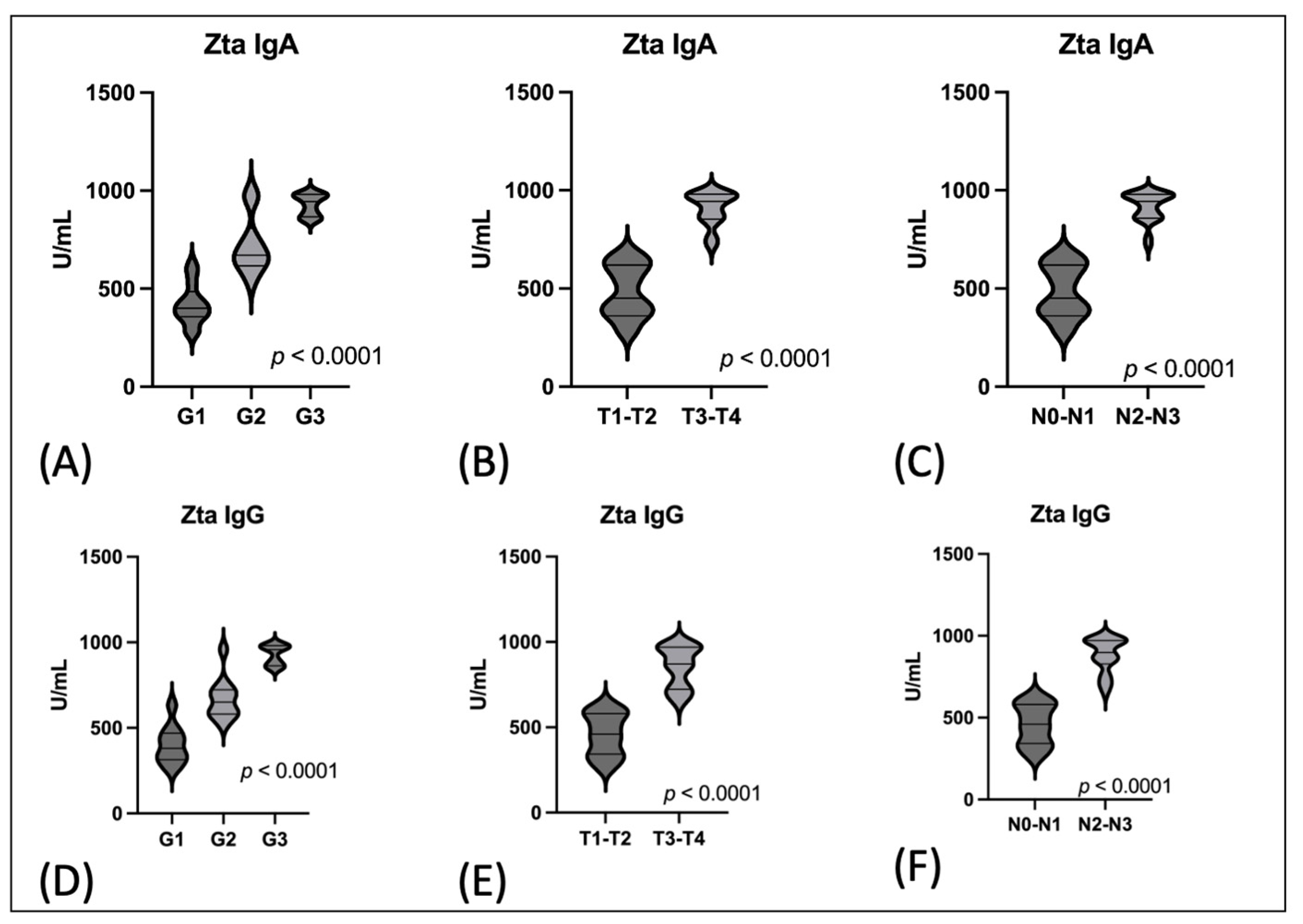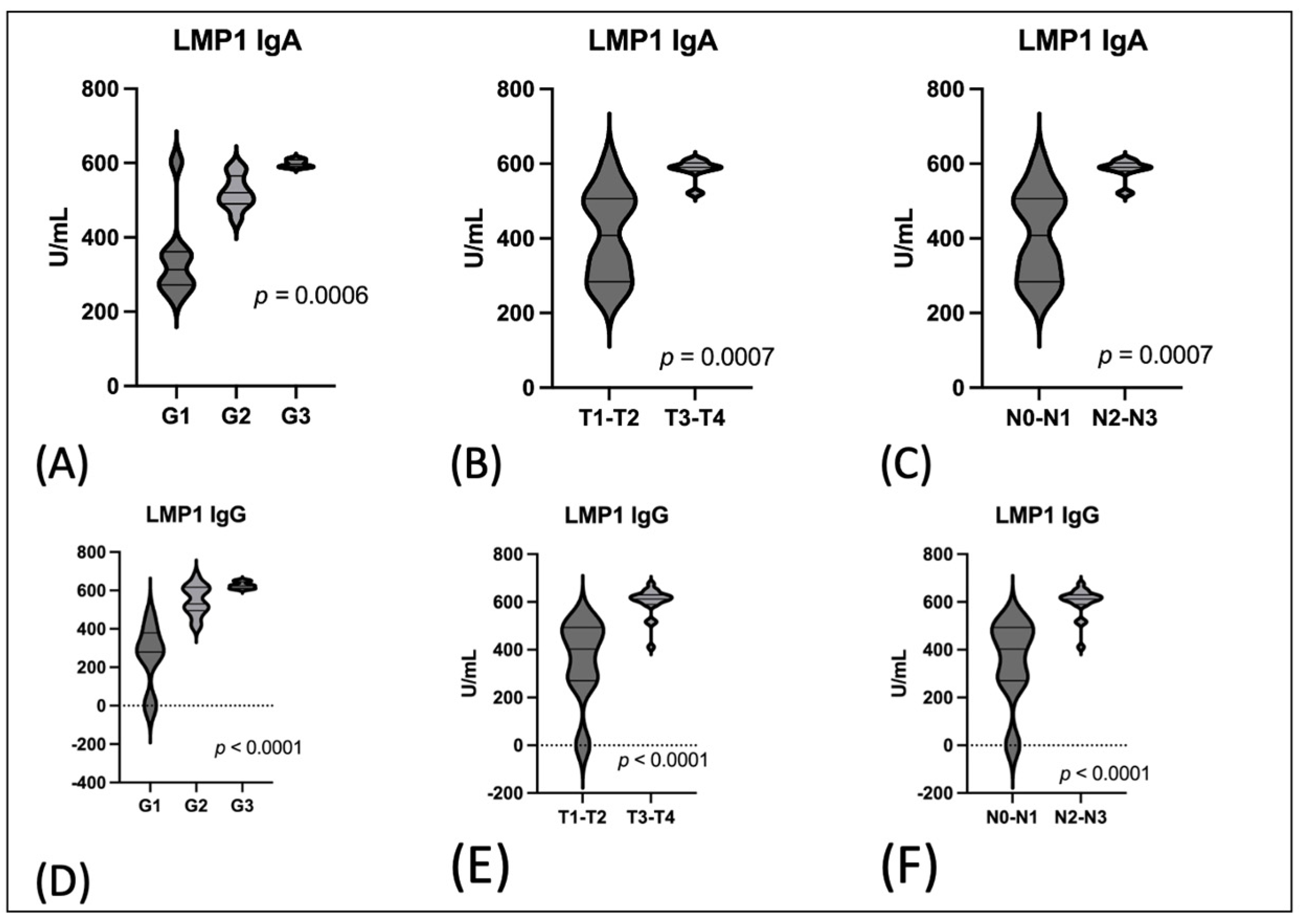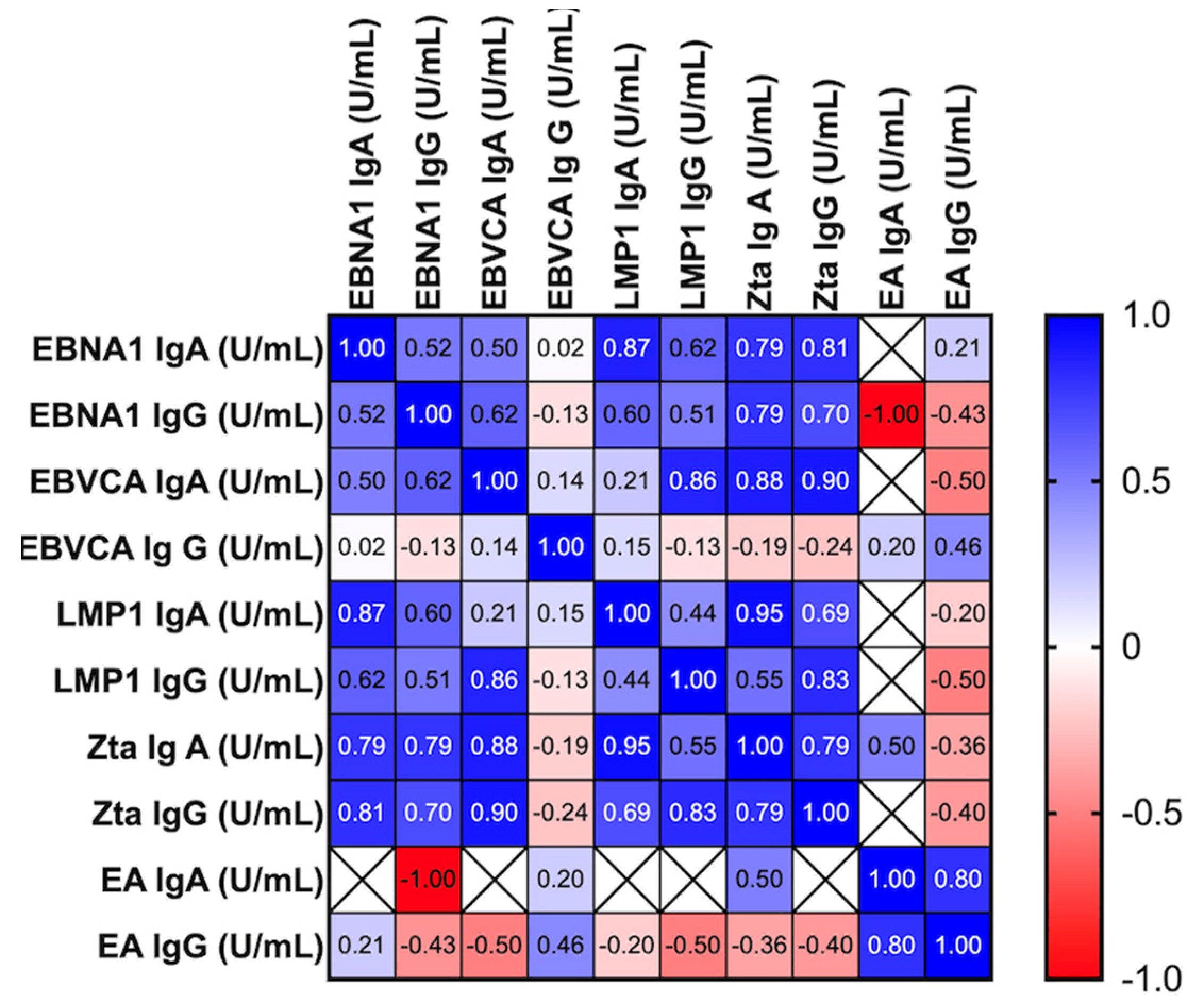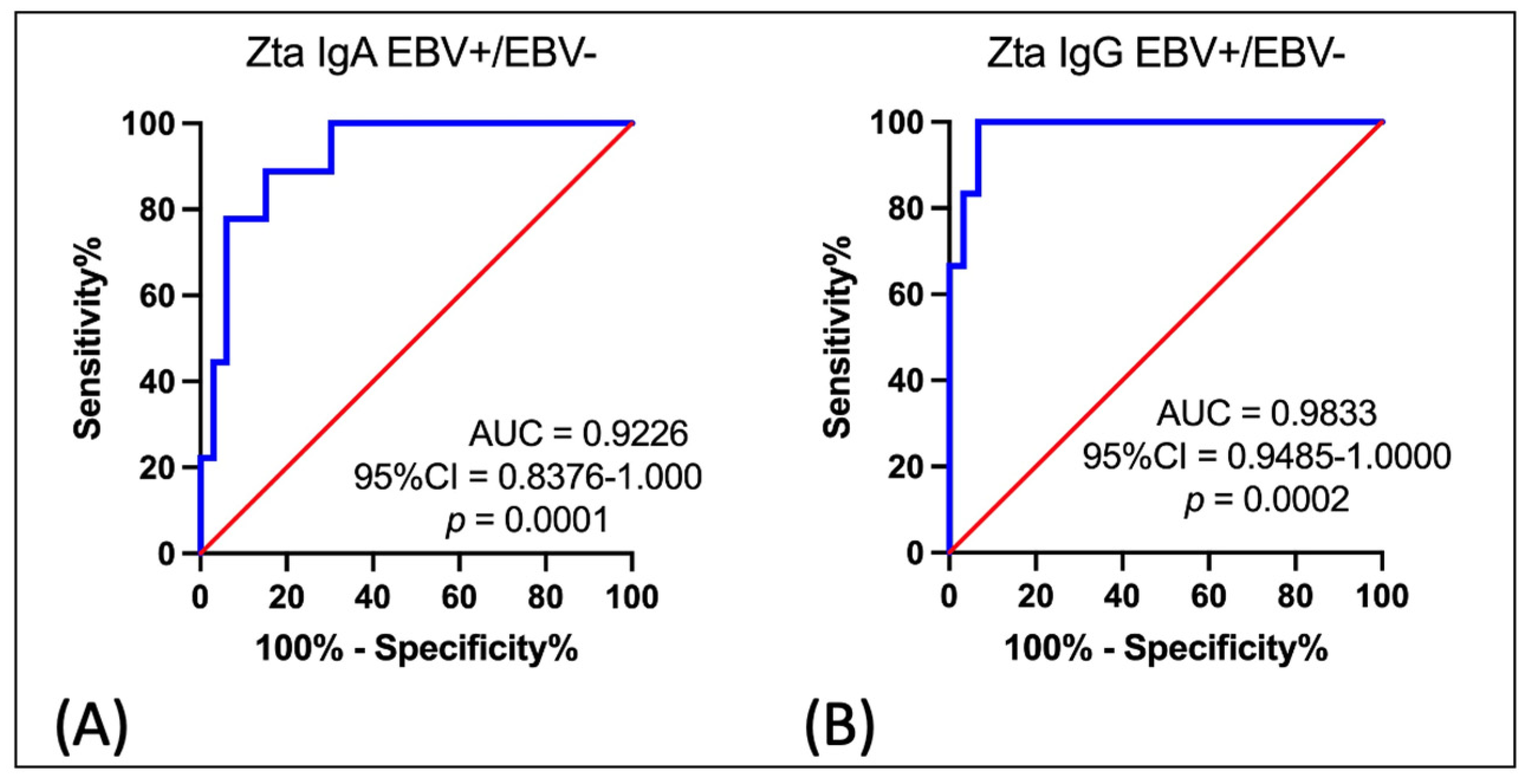Serum Anti-Zta and Anti-LMP1 Antibodies in Oropharyngeal Cancer Related to Epstein–Barr Virus—Diagnostic Usefulness
Abstract
Simple Summary
Abstract
1. Introduction
2. Materials and Methods
2.1. Patients
2.2. Clinical Specimens
2.2.1. Tissue Samples Collection
2.2.2. Serum Collection
2.3. Molecular Methods
2.3.1. DNA Extraction and Detection
2.3.2. HPV Detection
2.3.3. EBV Detection
2.4. Serological Methods
2.5. Statistical Methods
3. Results
3.1. Evaluation of the Serum Prevalence of Selected Anti-EBV in Oropharyngeal Cancer Patients in Comparison to the Control Group
Evaluation of the Serum Level of Selected Anti-EBV Antibodies in Oropharyngeal Cancer Patients in Comparison to the Control Group
3.2. The Frequencies of Anti-EBNA IgA, EBNA IgG, EBVCA IgA, and EBVCA IgG in OPSCC Patients in Relation to Grade (G1–G3)
The Frequencies of Anti-EBNA IgA, EBNA IgG, EBVCA IgA, and EBVCA IgG Antibodies in EBV Positive OPSCC Patients Depending on the TNM Classification
3.3. Detailed Assessment of the Significance of Anti-Zta and Anti-LMP1 Antibodies in Oropharyngeal Cancer Linked to EBV Infection
3.3.1. Evaluation of the Frequencies and Serum Levels of Anti-Zta and Anti-LMP1 in Oropharyngeal Cancer Patients Depending on the Grading (G1–G3) and TNM Classification
The Frequencies of Anti-Zta and Anti-LMP1 in Oropharyngeal Cancer Patients Depending on the Grading (G1–G3)
The Frequencies of Anti-Zta and Anti-LMP1 in Oropharyngeal Cancer Patients Depending on the TNM Classification
The Serum Level of Anti-Zta and Anti-LMP1 in Oropharyngeal Cancer Patients Depending on the Grading (G1–G3) and TNM Classification
3.4. Correlation between the Level of All Tested Antibodies with Particular Emphasis on Anti-Zta and Anti-EBNA1 Antibodies in Serum of EBV Positive OPSCC Patients
- The concentration of EBNA1 IgA and Zta IgA p < 0.0001; Zta IgG p < 0,0001; LMP1 IgG p < 0.0001; LMP1 IgA p = 0.0001; EBNA1 IgG p = 0.0001;
- The level of anti-Zta antibodies both in the IgA and IgG classes and anti-LMP1 IgA and IgG p < 0.0001. We also observed a correlation between the level of EBNA1 IgA and EBNA1 IgG p = 0.03; LMP1 IgA p = 0.007; LMP1IgG p = 0.02. However, they are less important for the issue at hand. The level of EA antibodies did not show any relationship with any of the tested parameters.
3.5. Receiver Operating Characteristic (ROC) Curve Analysis to Determine the Diagnostic Accuracy of Serum Anti-Zta IgA Antibody Level in OPSCC Patients EBV Positive vs. OPSCC Patients EBV Negative
4. Discussion
Criteria Qualifying Patients for the Research Group
5. Conclusions
Author Contributions
Funding
Institutional Review Board Statement
Informed Consent Statement
Data Availability Statement
Conflicts of Interest
References
- Wojciechowska, U.; Didkowska, J. Polish National Cancer Registry. Available online: http://onkologia.org.pl/nowotwory-narzadow-glowy-i-szyi/ (accessed on 8 November 2023).
- Chen, C.J.; Hsu, W.L.; Yang, H.I.; Lee, M.H.; Chen, H.C.; Chien, Y.C.; You, S.L. Epidemiology of virus infection and human cancer. Recent Results Cancer Res. 2014, 193, 11–32. [Google Scholar]
- Carpén, T.; Syrjanen, S.; Jouhi, L.; Randen-Brady, R.; Haglund, C.; Mäkitie, A.; Mattila, P.S.; Hagström, J. Epstein-Barr Virus (EBV) and Polyomaviruses Are Detectable in Oropharyngeal Cancer and EBV May Have Prognostic Impact. Cancer Immunol. Immunother. 2020, 69, 1615–1626. [Google Scholar] [CrossRef]
- Current ICTV Taxonomy Release. Available online: https://ictv.global/taxonomy (accessed on 27 November 2023).
- Damania, B.; Kenney, S.C.; Raab-Traub, N. Epstein-Barr virus: Biology and clinical disease. Cell 2022, 185, 3652–3670. [Google Scholar] [CrossRef] [PubMed]
- World Health Organization; International Agency for Research on Cancer. IARC Monographs on the Evaluation of Carcinogenic Risks to Humans. A Review of Human Carcinogens. Biological Agents; International Agency for Research on Cancer: Lyon, France, 2012; pp. 49–92. [Google Scholar]
- Shannon-Lowe, C.; Rickinson, A. The Global Landscape of EBV-Associated Tumors. Front. Oncol. 2019, 9, 713. [Google Scholar] [CrossRef] [PubMed]
- Liu, S.; Zhao, Z.; Han, L.; Liu, S.; Luo, B. Epstein-Barr Virus Infection in Gastric Remnant Carcinoma and Recurrent Gastric Carcinoma in Qingdao of Northern China. PLoS ONE 2016, 11, e0148342. [Google Scholar] [CrossRef] [PubMed]
- Chen, X.Z.; Che, H.; Castro, F.H.; Hu, J.; Brenner, H. Epstein-Barr virus infection and gastric cancer: A systematic review. Medicine 2015, 94, e792. [Google Scholar] [CrossRef] [PubMed]
- Young, L.S.; Dawson, C.W. Epstein-Barr virus and nasopharyngeal carcinoma. Chin. J. Cancer 2014, 33, 581–590. [Google Scholar] [CrossRef]
- Tsao, S.-W.; Tsang, C.M.; To, K.-F.; Lo, K.-W. The role of Epstein-Barr virus in epithelial malignancies. J. Pathol. 2014, 235, 323–333. [Google Scholar] [CrossRef]
- Young, L.S.; Yap, L.F.; Murray, P.G. Epstein–Barr virus: More than 50 years old and still providing surprises. Nat. Rev. Cancer 2016, 16, 789–802. [Google Scholar] [CrossRef]
- Chakravorty, S.; Yan, B.; Wang, C.; Wang, L.; Quaid, J.T.; Lin, C.F.; Briggs, S.D.; Majumder, J.; Canaria, D.A.; Chauss, D.; et al. Integrated Pan-Cancer Map of EBV-Associated Neoplasms Reveals Functional Host–Virus Interactions. Cancer Res. 2019, 79, 6010–6023. [Google Scholar] [CrossRef]
- He, Y.Q.; Xue, W.Q.; Xu, F.H.; Xu, Y.F.; Zhang, J.B.; Yu, H.L.; Feng, Q.S.; Chen, L.Z.; Cao, S.M.; Liu, Q.; et al. The Relationship Between Environmental Factors and the Profile of Epstein-Barr Virus Antibodies in the Lytic and Latent Infection Periods in Healthy Populations from Endemic and Non-Endemic Nasopharyngeal Carcinoma Areas in China. EBioMedicine 2018, 30, 184–191. [Google Scholar] [CrossRef] [PubMed]
- Globocan 2020. IARC WHO. Available online: https://gco.iarc.fr/today/data/factsheets/populations/616-poland-fact-sheets.pdf (accessed on 17 November 2023).
- Münz, C. Latency and lytic replication in Epstein–Barr virus-associated oncogenesis. Nat. Rev. Microbiol. 2019, 17, 691–700. [Google Scholar] [CrossRef]
- Kikuchi, K.; Noguchi, Y.; de Rivera, M.W.; Hoshino, M.; Sakashita, H.; Yamada, T.; Inoue, H.; Miyazaki, Y.; Nozaki, T.; González-López, B.S.; et al. Detection of Epstein-Barr virus genome and latent infection gene expression in normal epithelia, epithelial dysplasia, and squamous cell carcinoma of the oral cavity. Tumour Biol. 2016, 37, 3389–3404. [Google Scholar] [CrossRef] [PubMed]
- Inagaki, T.; Sato, Y.; Ito, J.; Takaki, M.; Okuno, Y.; Yaguchi, M.; Al Masud, H.M.A.; Watanabe, T.; Sato, K.; Iwami, S.; et al. Direct Evidence of Abortive Lytic Infection-Mediated Establishment of Epstein-Barr Virus Latency during B-Cell Infection. Front. Microbiol. 2020, 11, 575255. [Google Scholar] [CrossRef] [PubMed]
- Wang, L.; Ning, S. New Look of EBV LMP1 Signaling Landscape. Cancers 2021, 13, 5451. [Google Scholar] [CrossRef]
- Chen, Y.P.; Chan, A.T.C.; Le, Q.T.; Blanchard, P.; Sun, Y.; Ma, J. Nasopharyngeal carcinoma. Lancet 2019, 394, 64–80. [Google Scholar] [CrossRef]
- Cao, Y.; Xie, L.; Shi FTang, M.; Li, Y.; Zhao, L.; Yu, X.; Luo, X.; Liao, W.; Bode, A.M. Targeting the signaling in Epstein–Barr virus-associated diseases: Mechanism, regulation, and clinical study. Sig. Transduct. Target. Ther. 2021, 6, 15. [Google Scholar] [CrossRef]
- Amon, W.; Farrell, P.J. Reactivation of Epstein-Barr virus from latency. Rev. Med. Virol. 2005, 15, 149–156. [Google Scholar] [CrossRef]
- Godfrey, A.; Osborn, K.; Sinclair, A.J. Interaction sites of the Epstein-Barr virus Zta transcription factor with the host genome in epithelial cells. Access Microbiol. 2021, 26, 000282. [Google Scholar] [CrossRef]
- Abdulamir, A.S.; Hafidh, R.R.; Abu Bakar, F.; Abbas, K. Novel Epstein-Barr virus immunoglobulin G-based approach for the specific detection of nasopharyngeal carcinoma. Am. J. Otolaryngol. 2010, 31, 410–417. [Google Scholar] [CrossRef]
- Linde, A. Diagnosis of Epstein-Barr virus-related diseases. Scand. J. Infect. Dis. 1996, 100, 83–88. [Google Scholar]
- Tay, J.K.; Chan, S.H.; Lim, C.M.; Siow, C.H.; Goh, H.L.; Loh, K.S. The role of Epstein-Barr virus DNA load and serology as screening tools for nasopharyngeal carcinoma. WJOHNS 2016, 155, 274–280. [Google Scholar] [CrossRef] [PubMed]
- De Paschale, M.; Clerici, P. Serological diagnosis of Epstein-Barr virus infection: Problems and solutions. World J. Virol. 2012, 1, 31–43. [Google Scholar] [CrossRef] [PubMed]
- Chang, K.P.; Hsu, C.L.; Chang, Y.L.; Tsang, N.M.; Chen, C.K.; Lee, T.J.; Tsao, K.C.; Huang, C.G.; Chang, Y.S.; Yu, J.S.; et al. Complementary serum test of antibodies to Epstein-Barr virus nuclear antigen-1 and early antigen: A possible alternative for primary screening of nasopharyngeal carcinoma. Oral. Oncol. 2008, 44, 784–792. [Google Scholar] [CrossRef] [PubMed]
- Zeng, Y.; Zhang, L.G.; Wu, Y.C.; Huang, Y.S.; Huang, N.Q.; Li, J.Y.; Wang, Y.B.; Jiang, M.K.; Fang, Z.; Meng, N.N. Prospective studies on nasopharyngeal carcinoma in Epstein-Barr virus IgA/VCA antibody-positive persons in Wuzhou City. China. Int. J. Cancer 1985, 36, 545–547. [Google Scholar] [CrossRef]
- Rowe, M.; Rowe, D.T.; Gregory, C.D.; Young, L.S.; Farrell, P.J.; Rupani, H.; Rickinson, A.B. Differences in B cell growth phenotype reflect novel patterns of Epstein-Barr virus latent gene expression in Burkitt’s lymphoma cells. EMBO J. 1987, 6, 2743–2751. [Google Scholar] [CrossRef] [PubMed]
- Amin, M.B.; Edge, S.B.; Greene, F.L.; Byrd, D.R.; Brookland, R.K.; Washington, M.K.; Gershenwald, J.E.; Compton, C.C.; Hess, K.R.; Sullivan, D.C.; et al. (Eds.) AJCC Cancer Staging Manual, 8th ed.; Springer: New York, NY, USA, 2017. [Google Scholar]
- Amin, M.B.; Greene, F.L.; Edge, S.B.; Compton, C.C.; Gershenwald, J.E.; Brookland, R.K.; Meyer, L.; Gress, D.M.; Byrd, D.R.; Winchester, D.P. The Eighth Edition AJCC Cancer Staging Manual: Continuing to build a bridge from a population-based to a more “personalized” approach to cancer staging. CA Cancer J. Clin. 2017, 67, 93–99. [Google Scholar] [CrossRef]
- Machczyński, P.; Majchrzak, E.; Niewinski, P.; Marchlewska, J.; Golusiński, W. A review of the 8th edition of the AJCC staging system for oropharyngeal cancer according to HPV status. Eur. Arch. Otorhinolaryngol. 2020, 277, 2407–2412. [Google Scholar] [CrossRef]
- WHO Classification of Tumours Editorial Board. WHO Classification of Tumours Editorial Board. WHO classification of tumours series. In Head and Neck Tumours, 5th ed.; International Agency for Research on Cancer: Lyon, France, 2022; Volume 9. [Google Scholar]
- Polz-Gruszka, D.; Stec, A.; Dworzański, J.; Polz-Dacewicz, M. EBV, HSV, CMV and HPV in laryngeal and oropharyngeal carcinoma in polish patients. Anticancer. Res. 2015, 35, 1657–1661. [Google Scholar]
- Broccolo, F.; Ciccarese, G.; Rossi, A.; Anselmi, L.; Drago, F.; Toniolo, A. Human papillomavirus (HPV) and Epstein-Barr virus (EBV) in keratinizing versus non- keratinizing squamous cell carcinoma of the oropharynx. Infect. Agent. Cancer 2018, 9, 32–36. [Google Scholar] [CrossRef]
- Dardari, R.; Menezes, J.; Drouet, E.; Joab, I.; Benider, A.; Bakkali, H.; Kanouni, L.; Jouhadi, H.; Benjaafar, N.; El Gueddari, B.; et al. Analyses of the prognostic significance of the Epstein-Barr virus transactivator ZEBRA protein and diagnostic value of its two synthetic peptides in nasopharyngeal carcinoma. J. Clin. Virol. 2008, 41, 96–103. [Google Scholar] [CrossRef] [PubMed]
- Liu, W.; Chen, G.; Gong, X.; Wang, Y.; Zheng, Y.; Liao, X.; Liao, W.; Song, N.L.; Xu, J.; Zhang, X. The diagnostic value of EBV-DNA and EBV-related antibodies detection for nasopharyngeal carcinoma: A metaanalysis. Cancer Cell Int. 2021, 21, 164–177. [Google Scholar] [CrossRef] [PubMed]
- Dardari, R.; Khyatti, M.; Benider, A.; Jouhadi, H.; Kahlain, A.; Cochet, C.; Mansouri, A.; El Gueddari, B.; Benslimane, A.; Joab, I. Antibodies to the Epstein-Barr virus transactivator protein (ZEBRA) as a valuable biomarker in young patients with nasopharyngeal carcinoma. Int. J. Cancer 2000, 86, 71–75. [Google Scholar] [CrossRef]
- Mathew, A.; Cheng, H.M.; Sam, C.K.; Joab, I.; Prasad, U.; Cochet, C. A high incidence of serum IgG antibodies to the Epstein-Barr virus replication activator protein in nasopharyngeal carcinoma. Cancer Immunol. Immunother. 1994, 38, 68–70. [Google Scholar] [CrossRef] [PubMed]
- Zhang, G.; Li, Z.; Zhou, Q. Utility of Serum EB Virus Zta Antibody in the Diagnostic of Nasopharyngeal Carcinoma: Evidences from 2126 Cases and 15,644 Controls. Front. Oncol. 2019, 9, 1391. [Google Scholar] [CrossRef] [PubMed]
- Cao, S.M.; Liu, Z.; Jia, W.H.; Huang, Q.H.; Liu, Q.; Guo, X.; Huang, T.B.; Ye, W.; Hong, M.H. Fluctuations of Epstein-Barr virus serological antibodies and risk for nasopharyngeal carcinoma: A prospective screening study with a 20-year follow-up. PLoS ONE 2011, 6, e19100. [Google Scholar] [CrossRef]
- Ji, M.F.; Wang, D.K.; Yu, Y.L.; Guo, Y.Q.; Liang, J.S.; Cheng, W.M.; Zong, Y.S.; Chan, K.H.; Ng, S.P.; Wei, W.I.; et al. Sustained elevation of Epstein-Barr virus antibody levels preceding clinical onset of nasopharyngeal carcinoma. Br. J. Cancer 2007, 96, 623–630. [Google Scholar] [CrossRef]
- Liu, Y.; Huang, Q.; Liu, W.; Liu, Q.; Jia, W.; Chang, E.; Chen, F.; Liu, Z.; Guo, X.; Mo, H.; et al. Establishment of VCA and EBNA1 IgA-based combination by enzyme-linked immunosorbent assay as preferred screening method for nasopharyngeal carcinoma: A two-stage design with a preliminary performance study and a mass screening in southern China. Int. J. Cancer 2012, 31, 406–416. [Google Scholar] [CrossRef]
- Chien, Y.C.; Chen, J.Y.; Liu, M.Y.; Yang, H.I.; Hsu, M.M.; Chen, C.J.; Yang, C.S. Serologic markers of Epstein-Barr virus infection and nasopharyngeal carcinoma in Taiwanese men. N. Engl. J. Med. 2001, 345, 1877–1882. [Google Scholar] [CrossRef]
- Zhong, L.; Krummenacher, C.; Zhang, W.; Hong, J.; Feng, Q.; Chen, Y.; Zhao, Q.; Zeng, M.-S.; Zeng, Y.-X.; Xu, M.; et al. Urgency and necessity of Epstein-Barr virus prophylactic vaccines. Npj Vaccines 2022, 7, 159. [Google Scholar] [CrossRef]
- Drop, B.; Strycharz-Dudziak, M.; Kliszczewska, E.; Polz-Dacewicz, M. Coinfection with Epstein-Barr Virus (EBV), Human Papilloma Virus (HPV) and Polyoma BK Virus (BKPyV) in Laryngeal, Oropharyngeal and Oral Cavity Cancer. Int. J. Mol. Sci. 2017, 18, 2752. [Google Scholar] [CrossRef] [PubMed]
- Blanco, R.; Carrillo-Beltrán, D.; Corvalán, A.H.; Aguayo, F. High-Risk Human Papillomavirus and Epstein–Barr Virus Coinfection: A Potential Role in Head and Neck Carcinogenesis. Biology 2021, 10, 1232. [Google Scholar] [CrossRef] [PubMed]




| EBV | p | Total Patients | Control Group | p | |||||||
|---|---|---|---|---|---|---|---|---|---|---|---|
| Positive | Negative | ||||||||||
| N | % | N | % | N = 110 | % | N = 40 | % | ||||
| Sex | Female | 8 | 13.8 | 7 | 13.5 | 0.9999 | 15 | 13.8 | 6 | 15.0 | 0.7957 |
| Male | 50 | 86.2 | 45 | 86.5 | 95 | 86.2 | 34 | 85.0 | |||
| Age | 50–59 | 27 | 46.6 | 24 | 46.2 | 0.1116 | 59 | 53.4 | 21 | 52.5 | 0.9999 |
| 60–79 | 31 | 53.4 | 28 | 53.8 | 51 | 46.6 | 19 | 47.5 | |||
| Place of residence | Urban | 41 | 70.7 | 36 | 69.2 | 0.1667 | 77 | 70.7 | 28 | 70.0 | 0.9999 |
| Rural | 17 | 29.3 | 16 | 30.8 | 33 | 29.3 | 12 | 30.0 | |||
| Smoking | Yes | 38 | 65.8 | 35 | 67.3 | 0.8427 | 73 | 65.8 | 26 | 65.0 | 0.9999 |
| No | 20 | 34.5 | 17 | 32.7 | 37 | 34.5 | 14 | 35.0 | |||
| Alcohol abuse | Yes | 28 | 48.3 | 25 | 48.1 | 0.9834 | 53 | 48.3 | 19 | 47.5 | 0.9999 |
| No | 30 | 51.7 | 27 | 51.9 | 57 | 51.7 | 21 | 52.5 | |||
| G | G1 | 19 | 32.8 | 17 | 32.7 | 0.9997 | |||||
| G2 | 30 | 51.7 | 27 | 51.9 | |||||||
| G3 | 9 | 15.5 | 8 | 15.4 | |||||||
| T | T1 | 7 | 12.1 | 8 | 15.4 | 0.9505 | |||||
| T2 | 27 | 46.6 | 22 | 42.3 | |||||||
| T3 | 16 | 27.6 | 15 | 28.8 | |||||||
| T4 | 8 | 13.7 | 7 | 12.1 | |||||||
| N0 | 23 | 39.7 | 22 | 42.3 | |||||||
| N | N1 | 11 | 19.0 | 10 | 19.2 | 0.9844 | |||||
| N2 | 14 | 24.1 | 11 | 21.2 | |||||||
| N3 | 10 | 17.2 | 9 | 17.3 | |||||||
| M | M0 | 58 | 100.0 | 52 | 100.0 | ||||||
| Parameters | EBV+ N = 58 N (%) | EBV− N = 52 N (%) | Control Group N = 40 N (%) | p Value | |
|---|---|---|---|---|---|
| EBVCA IgA IgG p | 19 (32.7) 51 (87.9) | 0.0007 * | - 32 (61.5) | - 26 (65.0) | 0.0005 * |
| EBNA IgA IgG p | 21 (36.2) 46 (79.3) | 0.0017 * | - 25 (48.1) | - 19 (47.5) | 0.0025 * |
| EA IgA IgG | 5 (8.6) 17 (29.3) | - - | - - | ||
| EBVCA IgM | - | - | - |
| Antibodies U/mL | Group | Mean | Median | Minimum | Maximum | SD | p Value |
|---|---|---|---|---|---|---|---|
| EBVCA IgG EBVCA IgA | EBV+ EBV− Control EBV+ | 775.2 514.6 512.0 505.8 | 837.5 515.4 515.4 456.9 | 248.9 385.2 385.2 243.6 | 980.9 622.3 622.4 923.6 | 188.7 60.37 66.75 197.9 | <0.0001 * |
| EBNA1 IgG EBNA1 IgA | EBV+ EBV− Control EBV+ EBV− Control | 487.0 375.6 357.0 683.2 - - | 490.9 360.2 320.8 745.9 - - | 230.4 290.5 280.5 260.5 - - | 655.1 562.1 465.8 902.5 - - | 117.3 68.56 68.87 230.7 - - | <0.0001 * |
| EA IgA EA IgG | EBV+ EBV− Control EBV+ EBV− Control | 392.0 - - 450.0 - - | 500.0 - - 395.0 - - | 213.0 - - 234.0 - - | 521.0 - - 948.0 - - | 160.0 - - 195.1 - - |
| Antibodies (%) | G1 N = 19 N (%) | G2 N = 30 N (%) | G3 N = 9 N (%) | p Value |
|---|---|---|---|---|
| EBNA IgA | 4 (21.5) | 9 (30.0) | 8 (88.9) | 0.002 * |
| EBNA IgG | 8 (42.1) | 29 (96.7) | 9 (100.0) | <0.001 * |
| EBVCA IgA | 3 (15.7) | 13 (43.3) | 8 (88.9) | 0.125 |
| EBVCA IgG | 18 (94.7) | 24 (80.0) | 9 (100.0) | 0.193 |
| Antibodies (%) | T1 N = 7 N (%) | T2 N = 27 N (%) | T3 N = 16 N (%) | T4 N = 8 N (%) | p Value |
|---|---|---|---|---|---|
| EBNA IgA | 1 (14.3) | 6 (22.2) | 7 (43.7) | 7 (87.5) | 0.004 * |
| IgG | 2 (28.6) | 20 (74.1) | 16 (100.0) | 8 (100.0) | <0.001 |
| EBVCA IgA | 0 | 11 (40.7) | 6 (37.5) | 2 (25.0) | 0.212 |
| IgG | 7 (100.0) | 19 (74.0) | 16 (100.0) | 8 (100.0) | 0.037 * |
| Antibodies | N0 N = 23 N (%) | N1 N = 11 N (%) | N2 N = 14 N (%) | N3 N = 10 N (%) | p Value |
| EBNA IgA | 6 (26.1) | 1 (9.1) | 5 (35.7) | 9 (90.0) | 0.001 * |
| IgG | 12 (52.1) | 10 (90.9) | 14 (100.0) | 10 (100.0) | <0.001 * |
| EBVCA IgA | 4 (17.4) | 7 (63.6) | 5 (35.7) | 3 (30.0) | 0.071 |
| IgG | 20 (86.9) | 7 (63.6) | 14 (100.0) | 10 (100.0) | 0.029 * |
| Antibodies | EBV+ N = 58 N (%) | EBV− N = 52 N (%) | p Value |
|---|---|---|---|
| Zta IgA | 33 (56.8) | 9 (17.3) | <0.0001 * |
| Zta IgG | 31 (53.4) | 6 (11.5) | <0.0001 * |
| LMP1 IgA | 21 (36.2) | - | |
| LMP1 IgG | 32 (55.1) | - |
| Antibodies (%) | G1 N = 19 N (%) | G2 N = 30 N (%) | G3 N = 9 N (%) | p Value |
|---|---|---|---|---|
| Zta IgA | 13 (68.4) | 11 (36.7) | 9 (100.0) | 0.0011 * |
| IgG | 10 (52.6) | 12 (40.0) | 8 (88.9) | 0.0229 * |
| LMP1 IgA | 8 (42.1) | 9 (30.0) | 4 (44.4) | 0.6104 |
| IgG | 7 (36.8) | 17 (56.7) | 8 (88.9) | 0.0346 * |
| Antibodies (%) | T1 N = 7 N (%) | T2 N = 27 N (%) | T3 N = 16 N (%) | T4 N = 8 N (%) | p Value |
|---|---|---|---|---|---|
| Zta IgA | 5 (71.4) | 13 (48.1) | 4 (25.0) | 7 (87.5) | 0.0208 * |
| Zta IgG | 2 (28.5) | 13 (48.1) | 8 (50.0) | 8 (100.0) | 0.0850 |
| LMP1 IgA | 3 (42.8) | 11 (40.7) | 4 (25.0) | 5 (62.5) | 0.3746 |
| LMP1 IgG | 2 (28.5) | 12 (44.4) | 2 (12.5) | 5 (62.5) | 0.1725 |
| Antibodies (%) | N0 N = 23 N (%) | N1 N = 11 N (%) | N2 N = 14 N (%) | N3 N = 10 N (%) | p Value |
| Zta IgA | 8 (34.7) | 0 | 4 (28.6) | 10 (100.0) | <0.001 * |
| IgG | 11 (47.8) | 4 (36.4) | 6 (42.8) | 9 (90.0) | 0.0532 |
| LMP1 IgA | 10 (43.4) | 4 (36.4) | 2 (14.3) | 5 (50.0) | 0.2293 |
| IgG | 7 (30.4) | 7 (63.6) | 9 (64.3) | 9 (90.0) | 0.0098 * |
Disclaimer/Publisher’s Note: The statements, opinions and data contained in all publications are solely those of the individual author(s) and contributor(s) and not of MDPI and/or the editor(s). MDPI and/or the editor(s) disclaim responsibility for any injury to people or property resulting from any ideas, methods, instructions or products referred to in the content. |
© 2024 by the authors. Licensee MDPI, Basel, Switzerland. This article is an open access article distributed under the terms and conditions of the Creative Commons Attribution (CC BY) license (https://creativecommons.org/licenses/by/4.0/).
Share and Cite
Polz, A.; Morshed, K.; Drop, B.; Drop, A.; Polz-Dacewicz, M. Serum Anti-Zta and Anti-LMP1 Antibodies in Oropharyngeal Cancer Related to Epstein–Barr Virus—Diagnostic Usefulness. Cancers 2024, 16, 341. https://doi.org/10.3390/cancers16020341
Polz A, Morshed K, Drop B, Drop A, Polz-Dacewicz M. Serum Anti-Zta and Anti-LMP1 Antibodies in Oropharyngeal Cancer Related to Epstein–Barr Virus—Diagnostic Usefulness. Cancers. 2024; 16(2):341. https://doi.org/10.3390/cancers16020341
Chicago/Turabian StylePolz, Anna, Kamal Morshed, Bartłomiej Drop, Andrzej Drop, and Małgorzata Polz-Dacewicz. 2024. "Serum Anti-Zta and Anti-LMP1 Antibodies in Oropharyngeal Cancer Related to Epstein–Barr Virus—Diagnostic Usefulness" Cancers 16, no. 2: 341. https://doi.org/10.3390/cancers16020341
APA StylePolz, A., Morshed, K., Drop, B., Drop, A., & Polz-Dacewicz, M. (2024). Serum Anti-Zta and Anti-LMP1 Antibodies in Oropharyngeal Cancer Related to Epstein–Barr Virus—Diagnostic Usefulness. Cancers, 16(2), 341. https://doi.org/10.3390/cancers16020341








